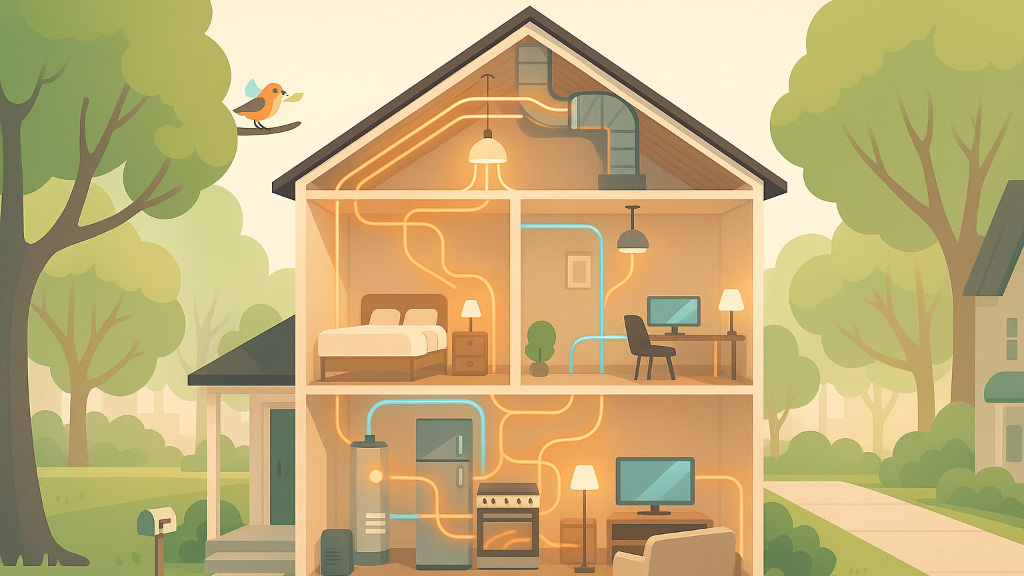Ever wondered why your energy bill keeps climbing despite your best efforts? The average North American home consumes 899 kWh monthly, with HVAC systems devouring 44-67% of total energy usage. Yet most homeowners have zero visibility into the consumption patterns that could save them hundreds annually through smarter home energy management.
Our comprehensive analysis across all U.S. homes, from scorching Arizona deserts to snowy Minnesota plains, reveals exactly where your energy dollars disappear throughout the year. The breakdown may surprise you—especially when you discover how just three systems control over half your total consumption.
This analysis draws from more than four decades of nationwide energy-use surveys, spanning from 1978 to 2020. Over that time, the energy landscape has dramatically shifted: heating has become less dominant as insulation and building efficiency improved, while cooling and electronics have claimed larger shares as air conditioning adoption and smart device ownership exploded.
Your home's energy breakdown by system and season
Remember when the biggest chunk of your energy bill came from just keeping the lights on? Those days are long gone. Today, nearly 30% of the average home’s energy use goes toward space heating — making it the single largest consumer in most households. Air conditioning claims another 14%, while water heating takes about 13%. Together, this trio dominates more than half of total household consumption.
The rest of your energy bill is spread across everyday essentials: lighting (9%), electronics (7%), and refrigeration (6%) each take noticeable slices. Smaller categories like cooking, laundry appliances, and computers may only claim a few percentage points individually, but together they add up.
And then there are the stealthy culprits, miscellaneous devices and standby power, quietly consuming around 4–5% without you ever flipping a switch. In other words, the battle for a lower energy bill starts with your heater, cooler, and water tank, but it’s often won in the details.
Home Energy Usage Breakdown
Why energy tracking transforms home management
To uncover where household energy really goes, we analyzed a massive, nationally representative dataset capturing the energy habits of nearly 18,500 U.S. homes. This data spans every climate zone, from snowy northern states to humid southern coasts, and reflects both urban and rural living.
The numbers aren’t just estimates. They combine in-home surveys with utility billing records, appliance inventories, and weather-adjusted models to produce a precise breakdown of energy use by category. By looking at this information across different home sizes, building ages, fuel types, and regional climates, we can see not just the totals, but the patterns that explain them.
Recent Shifts from the early 2000s to now
While heating still tops the list, data from the early 2000s through 2020 reveals notable changes. Space heating’s share dropped by several percentage points thanks to improved insulation, more efficient HVAC systems, and milder winters in many regions. Meanwhile, air conditioning’s share has grown as summers have become hotter and AC adoption has spread into regions where it was once rare. Electronics and standby power use have also ticked upward, reflecting the explosion of connected devices in our homes — from smart TVs to gaming consoles to always-on Wi-Fi equipment. These shifts suggest that while weather and climate still drive the biggest loads, lifestyle and technology choices are playing an ever-larger role in shaping our bills.
Regional Patterns: How Climate Shapes Your Energy Use
The national averages only tell part of the story — where you live can completely change your energy profile. In the frigid winters of Minnesota and North Dakota, space heating can consume well over 50% of a home’s annual energy use. Compare that to Florida or Texas, where air conditioning rivals heating and can account for more than a quarter of the total, especially during long, hot summers.
Out West, states like California and Oregon see a different balance. Milder climates mean less extreme heating or cooling demands, so a greater share of energy goes toward appliances, lighting, and electronics. Meanwhile, in the Northeast, older housing stock and cold winters combine to keep heating costs front and center, even as efficient technology tries to level the playing field.
Surprising Energy Profiles
But some states defy these trends entirely, here’s how.
Arizona’s Cooling Edge – Despite blistering summers, efficient HVAC systems and better-insulated construction keep cooling loads lower than you might expect for such a hot state.
Maine’s Hidden Heating Efficiency – Even with freezing winters, many homes rely on modern heat pumps and wood stoves, reducing reliance on high-cost electric or gas heating.
Hawaii’s Appliance Heavy Homes – With minimal heating or cooling needs, a larger share of energy goes toward refrigerators, lighting, and electronics — giving Hawaii one of the most appliance-driven energy profiles in the nation.
These outliers show how building practices, technology adoption, and even cultural habits can shape the way energy is used — sometimes more than the weather itself.
Start Your Complete Home Management Journey
If the goal is to save money and reduce waste, the data points to a clear strategy:
Target the Big Three – Upgrade heating, cooling, and water heating systems for the biggest impact.
Light the Way – Replace older bulbs with LEDs to trim one of the largest non-HVAC energy categories.
Control the Hidden Loads – Use smart plugs or timers to cut standby power use from idle electronics.
Think Regionally – Focus your upgrades on the category that dominates in your climate.
As technology advances and climate patterns shift, the balance of where our home energy goes will keep evolving — and the biggest savings will always come from knowing exactly where to focus.






